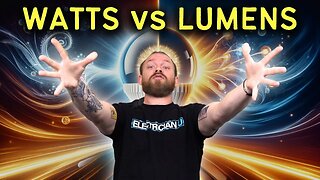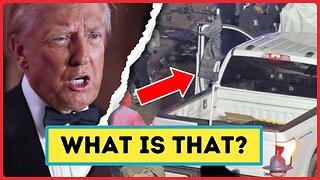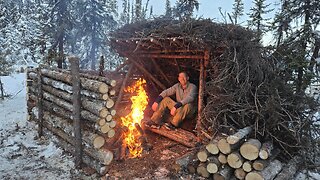Premium Only Content

BEST OF CODE TIME 2: Romex in Tubing, Ceiling Fans, J-Box Splices & Receptacles in Wet Locations
When installing any type of electrical work, we must adhere, at a minimum, to the most current version of the NEC. In todays episode of Electrician U, Dustin explores a few code references that are pertinent to many applications.
🤘⚡️MEMBERSHIP⚡️🤘
JOIN ELECTRICIAN U - become a member and get:
FREE Continuing Education every year
FREE Practice Exams
FREE Monthly Video Courses
FREE Weekly Live Instructor-Led Classes
FREE Monthly Educational Newsletter
Premium Members-Only Content
Private Discord Channel
Monthly Members-Only Discord Chats
Sign up here --- https://www.electricianu.com/electrician-u-membership/
🎧🎹MUSIC AND VIDEO:🎹🎧
https://www.facebook.com/descantmv
🎬✍️ART AND ILLUSTRATION:✍️🎬
https://www.daverussoart.com
Say we have a residence that has an exterior patio type area. And that patio has a masonry wall around the outside of it. Installed on that wall are exterior fixtures that need to be wired. Should we be putting Non-Metallic Cable (Type NM) inside Electrical Non-Metallic Tubing? Article 334.12B tells us that NM cable is NOT allowed in wet or damp locations. The reason for needing to know that, is most conduits, when installed underground, WILL be exposed to wet or damp conditions. So, keeping that in mind, moving over to article 100 definitions, we find that in an outside environment and underground, that would classify as a WET location. Finally, Article 300.5B, which covers underground installations, states that the interior of enclosures or raceways installed underground shall be considered WET locations and that conductors and cables installed within shall comply with 310.10C. In essence, 310.10C tells us that if we expose conductors to a wet location, they must be rated for that type of environment, which type NM cable is NOT.
NEC Code Article 314.27C tells us what boxes we must use when installing a ceiling fan. In essence, it tells us that boxes used for the sole support of ceiling fans must be listed, marked, and not support fans in excess of 70 lbs. For outlet boxes and outlet box systems designed to support ceiling fans that weigh more than 35 lbs., they also must be marked with the maximum weight supported. It furthermore tells us that in ceilings of habitable rooms of DWELLING OCCUPANCIES, in locations ACCEPTABLE for the installation of a ceiling fan, that we must provide a fan rated box. This means for a room within a residence, if you COULD at some point put a fan in that location, we must install a fan rated box. Reason being is, after we, the installing electrician leaves, we have no idea as to what that new owner will install, and we must leave them with an installation that would be safe for them to install a ceiling fan.
Article 314.29 requires us to install splices inside junction boxes, conduit bodies and handhole enclosures so that the wiring inside them can be accessible without removing any part of the building or structure. So, you must install your splice points where you can get after it without, for instance, having to cut a hole in the drywall.
Article 406 governs the usage of receptacles. 406.9 tells us that for wet or damp locations we must use weather resistant receptacles and for wet locations that installation must further be enclosed by something that is weatherproof regardless of whether or not something is actually plugged into it (enter the while in use cover plate!). Article 406.12 covers tamper resistant receptacles and basically tells us that any receptacle installed within a dwelling unit, guest room/guest suite, childcare, education facilities, business offices, dorm units, or assisted living facilities must be of the tamper resistant types. So, if you had an outside receptacle at a residence, it must be rated both WR and TR.
We hope this has been insightful in understanding a few of the code requirements that you are liable to run into while performing electrical installations. Is there a topic you would like to see discussed in a video? Leave a comment in the section below and let us know. Please continue to follow Dustin and Electrician U as we are constantly adding new content to help our followers become the best electricians possible!
-
 6:27
6:27
Electrician U
1 year ago💡 Watts vs Lumens: The New Lighting Standard You Need to Know! 💡
6.91K6 -
 LIVE
LIVE
Pepkilla
5 hours agoRanked Warzone ~ Are we getting to platinum today or waaa
614 watching -
 LIVE
LIVE
BrancoFXDC
3 hours ago $1.25 earnedHAPPY NEW YEARS - Road to Platinum - Ranked Warzone
434 watching -
 5:53
5:53
SLS - Street League Skateboarding
5 days agoBraden Hoban’s San Diego Roots & Hometown Win | Kona Big Wave “Beyond The Ride” Part 2
48K12 -
 6:03:57
6:03:57
TheBedBug
8 hours ago🔴 LIVE: EPIC CROSSOVER - PATH OF EXILE 2 x MARVEL RIVALS
36.2K1 -
 1:12:45
1:12:45
The Quartering
5 hours agoTerror In New Orleans, Attacker Unmasked, Tesla BLOWS UP At Trump Tower! Are We Under Attack?
85.2K98 -
 1:32:08
1:32:08
Robert Gouveia
7 hours agoNew Year TERROR; Trump Speaks at Mar-a-Lago; Speaker Johnson FIGHT
75.2K63 -
 22:21
22:21
Russell Brand
1 day agoVaccines Don't Cause Autism*
152K695 -
 2:05:27
2:05:27
The Dilley Show
7 hours ago $20.92 earnedNew Years Agenda, New Orleans Terror Attack and More! w/Author Brenden Dilley 01/01/2025
88.1K34 -
 25:45
25:45
Outdoor Boys
3 days ago3 Days in Arctic Survival Shelter - Solo Bushcraft Camping & Blacksmithing
65.5K21